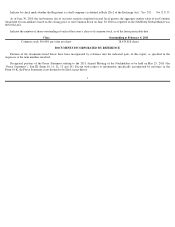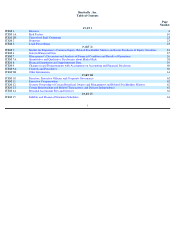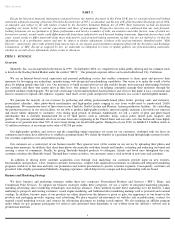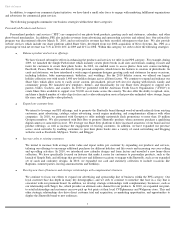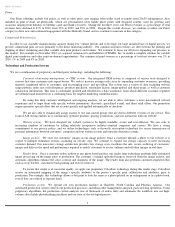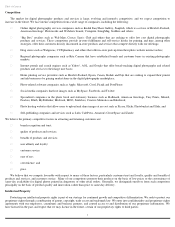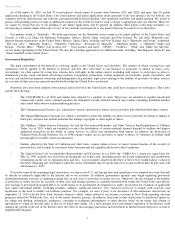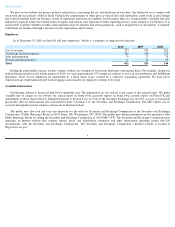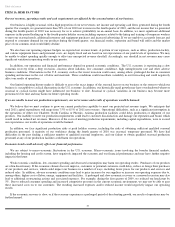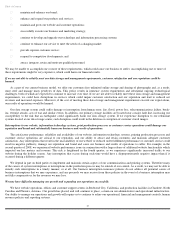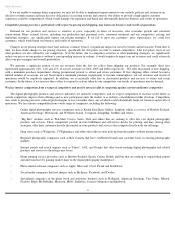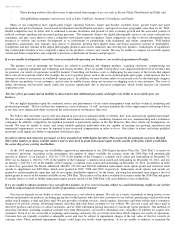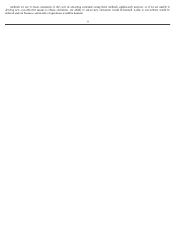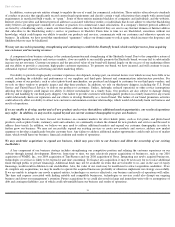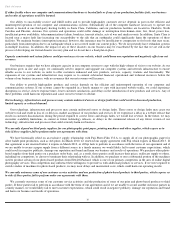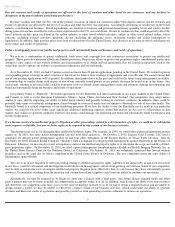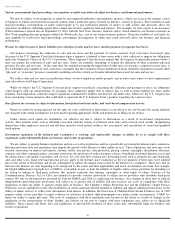Shutterfly 2011 Annual Report Download - page 13
Download and view the complete annual report
Please find page 13 of the 2011 Shutterfly annual report below. You can navigate through the pages in the report by either clicking on the pages listed below, or by using the keyword search tool below to find specific information within the annual report.
ITEM 1A. RISK FACTORS
Our net revenues, operating results and cash requirements are affected by the seasonal nature of our business.
Our business is highly seasonal, with a high proportion of our net revenues, net income and operating cash flows generated during the fourth
quarter. For example, we generated more than 50% of our 2010 net revenues in the fourth quarter of 2010, and the net income that we generated
during the fourth quarter of 2010 was necessary for us to achieve profitability on an annual basis. In addition, we incur significant additional
expenses in the period leading up to the fourth quarter holiday season including expenses related to the hiring and training of temporary workers
to meet our seasonal needs, additional inventory and equipment purchases and increased advertising. If we are unable to accurately forecast and
respond to consumer demand for our products during the fourth quarter, our financial results, reputation and brand will suffer and the market
price of our common stock would likely decline.
We also base our operating expense budgets on expected net revenue trends. A portion of our expenses, such as office, production facility,
and various equipment leases and personnel costs, are largely fixed and are based on our expectations of our peak levels of operations. We may
be unable to adjust spending quickly enough to offset any unexpected revenue shortfall. Accordingly, any shortfall in net revenues may cause
significant variation in operating results in any quarter.
In addition, our operations and financial performance depend on general economic conditions. The U.S. economy is experiencing a slow
economic recovery from a deep recession, concerns about inflation, low consumer confidence, high unemployment rate and other adverse
business conditions. Fluctuations in the U.S. economy such as the recent recession could cause, among others, prolonged decline in consumer
spending and increase in the cost of labor and materials. These conditions could exacerbate variability in our forecasting and could negatively
affect our results of operations.
Our limited operating history makes it difficult to assess the exact impact of the seasonal factors on our business or the extent to which our
business is susceptible to cyclical fluctuations in the U.S. economy. In addition, our historically rapid growth may have overshadowed whatever
seasonal or cyclical factors might have influenced our business to date. Seasonal or cyclical variations in our business may become more
pronounced over time and may harm our future operating results.
If we are unable to meet our production requirements, our net revenues and results of operations would be harmed.
We believe that we must continue to grow our current production capability to meet our projected net revenue targets. We anticipate that
total 2011 capital expenditures will range from 7.5% to 8.5% of 2011 net revenues. Operational difficulties, such as a significant interruption in
the operations of either our Charlotte, North Carolina or Phoenix, Arizona production facilities could delay production or shipment of our
products. Our inability to meet our production requirements could lead to customer dissatisfaction and damage our reputation and brand, which
would result in reduced net revenues. Moreover, if the costs of meeting production requirements, including capital expenditures, were to exceed
our expectations, our results of operations would be harmed.
In addition, we face significant production risks at peak holiday seasons, including the risks of obtaining sufficient qualified seasonal
production personnel. A majority of our workforce during the fourth quarter of 2010 was seasonal, temporary personnel. We have had
difficulties in the past finding a sufficient number of qualified seasonal employees, and our failure to obtain qualified seasonal production
personnel at any of our production facilities could harm our operations.
Economic trends could adversely affect our financial performance.
We are subject to macro-economic fluctuations in the U.S. economy. Macro-
economic issues involving the broader financial markets,
including the housing and credit system, have negatively impacted the economy and our financial performance and may have further negative
impact in the future.
Weak economic conditions, low consumer spending and decreased consumption may harm our operating results. Purchases of our products
are often discretionary. If the economic climate does not improve, customers or potential customers could delay, reduce or forego their purchases
of our products and services, which could impact our business in a number of ways, including lower prices for our products and services and
reduced sales. In addition, adverse economic conditions may lead to price increases by our suppliers or increase our operating expenses due to,
among others, higher costs of labor, energy, equipment and facilities. A prolonged and slow economic recovery or a renewed recession may also
lead to additional restructuring actions and associated expenses. For example, during the first quarter of 2009, we reduced our headcount by
5%. Due to reduced consumer spending and increased competitive pressures in the current economic environment, we may not be able to pass
these increased costs on to our customers. The resulting increased expenses and/or reduced income would negatively impact our operating
results.
If the economic recovery is slow, or if the economy experiences a prolonged period of decelerating growth, our results of operations may be
further harmed.
Table of Contents
10



